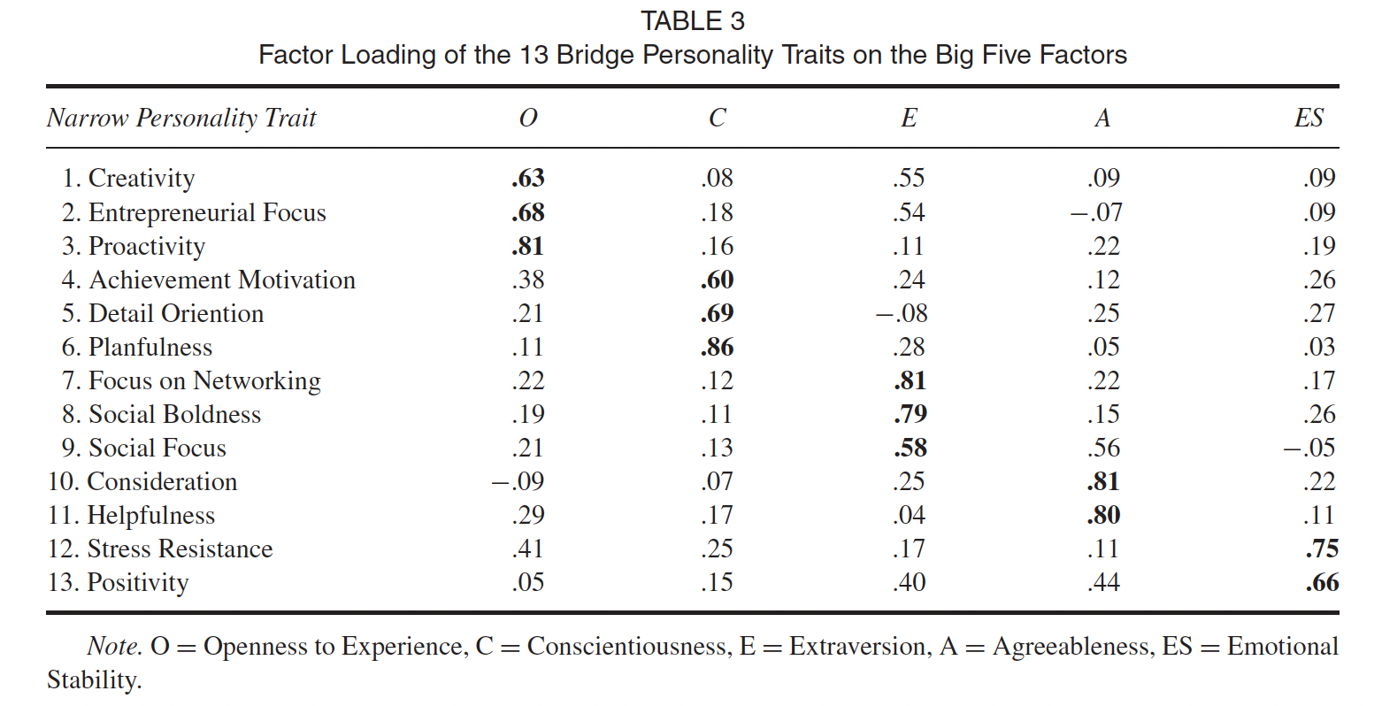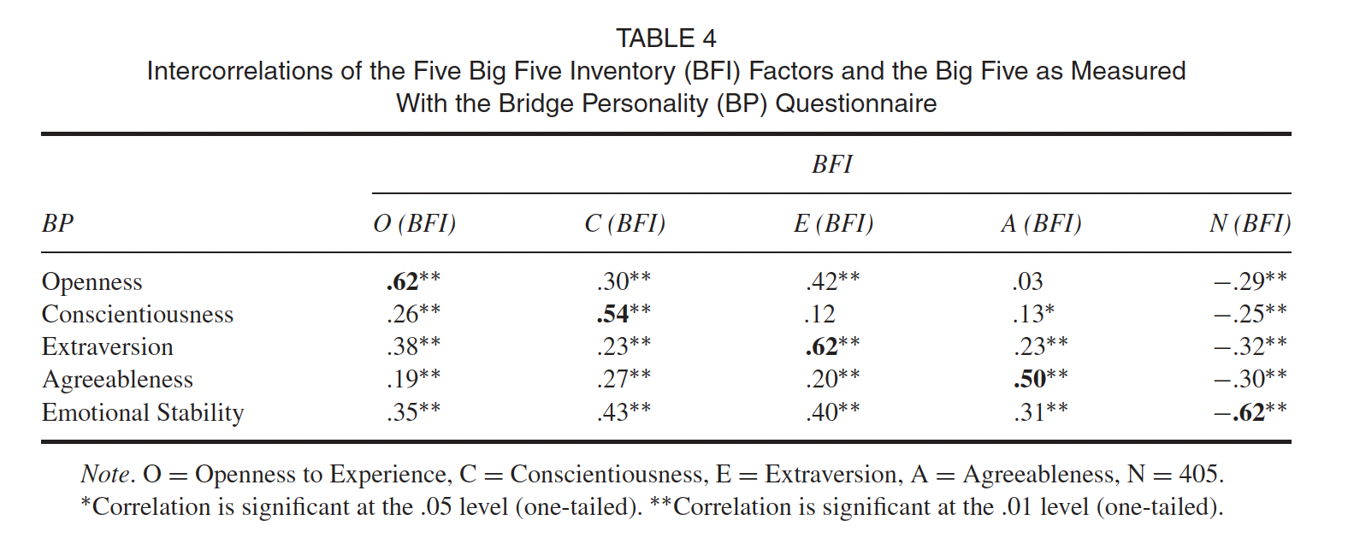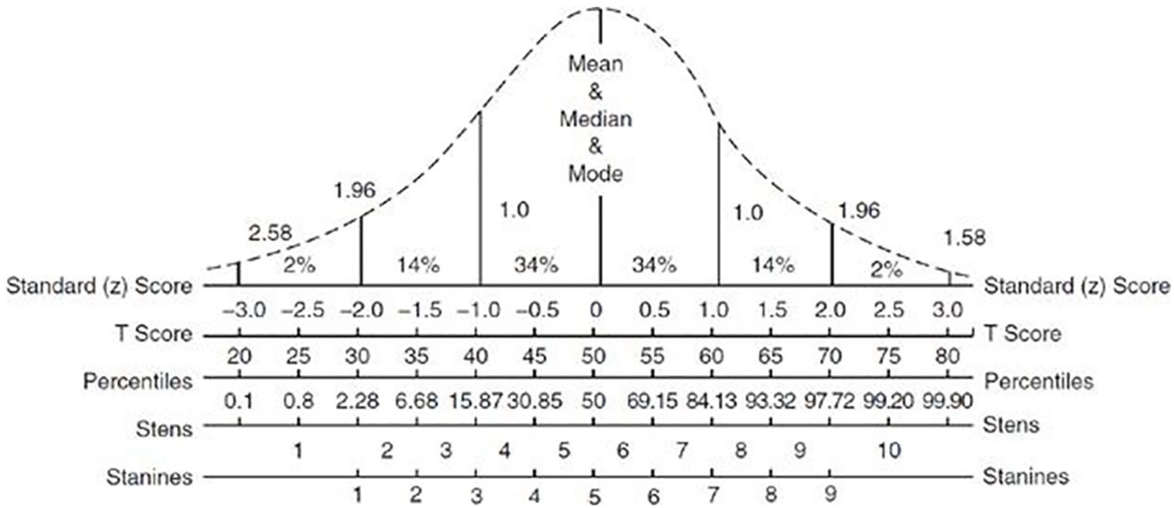Scientific foundation of The Bridge Personality
The Bridge Personality test was developed in 2006 by TestGroup in cooperation with universities worldwide. Since then, many scientific studies have shown the reliability and (predictive) validity of this personality test. Since the development of this high quality personality questionnaire, it has grown into the most used personality test in many countries worldwide. TestGroup is specialized in predicting job performance with personality questionnaires and aptitude tests. We consult organizations all over the world about implementing our online Bridge assessments in their HR processes.
Together with universities, TestGroup publishes scientific articles in high-class journals worldwide. Here you can download an example article of our research. This specific article on the validity of The Bridge Personality was published in Human Performance, a top 10 journal in the field of psychometrics and assessments.
Two personality models : The Big Five and the 16 Jung Types
The Bridge Personality is based on two personality theories: the Big Five personality theory and Carl Jung’s Type Theory. Candidates get 240 questions, in which they have to assess themselves in a work situation. The questions focus on 4 main groups: Directing, Output, Attitude and Inspiration. The 4 main groups are split into 12 main lines (e.g. Influence, Drive and Flexibility). The 12 main lines are subdivided in 34 dimensions (e.g. Socially Bold, Decisive and Helpful). The scientific validation of The Bridge Personality is only based on the Big Five personality model, as this is the only scientifically-proven personality model that can be used to predict behavior.
For Jung's theory, The Bridge Personality has a 16 personality test report and a 4-color personality test report. It's important to note that the Jung reports are not meant for recruitment or selection (or to predict any form of behavior), but can only be used for coaching and team development.
Reliability and validity
TestGroup attaches great value to reliability and validity. This is why the Bridge Personality has been developed in line with the latest scientific theories in test psychology. We also use the latest insights in the field of online testing. If you would like to know more about the most recent research details of the Bridge Personality, just see the table below for latest reliability scores of the Bridge Personality.
Construct validity of The Bridge Personality with the Big Five
To ensure the Bridge Personality test is still accurately measuring what it's supposed to, we analyzed its traits using a method called "principal component analysis." This was to check if The Bridge Personality has construct validity with the Big Five personality structure. Each of these Big Five traits includes two to three more specific traits. The Bridge Personality test has construct validity with the Big Five, as shown by the BFI in table 4. The BFI (Big Five Inventory), developed by John & Srivastava in 1999, is a quick, reliable 44-item questionnaire that gives an overview of a person's scores on the Big Five factors. The results showed good alignment between the Bridge Personality's Big Five scales and the corresponding scales in the BFI. The reliability scores in table 3 (alpha reliabilities) are very good, ranging from α = .82 for Agreeableness to α = .91 for Extraversion and Openness.


Normative and ipsative scores
The (sten)scores in the personality report are based on both normative and ipsative scores. Normative means that a candidate scores on a scale of 1 – 9 (1=very strong disagreement, 9=very strong agreement). Ipsative stands for ‘forced choice’ and means that candidates have to put questions in order(1=least applicable to me, 6=most applicable to me). Why this combination of scores? Because research within testing theory has shown that combining these scores gives a more reliable idea of self-perception and personality.
Stenscores explained
The Bridge Personality reports use sten scores that range from 1 to 10. A sten score shows where someone stands in a (norm)group, like a range, compared to others. The (norm)groups of The Bridge Personality differ per country (language of The Bridge Personality) and consists of 500 people that have completed The Bridge Personality. Generic norm groups are used where the norm groups for women and men are equal.
Sten scores are based on a standard normal distribution, which is a common way to look at data. Sten scores are different from stanine scores. Stanine scores have a middle point of five, but sten scores don't; their middle is actually 5.5. Both sten and stanine scores use half standard deviations to set their ranges. For example, a sten score of 5 covers all standard scores from -.5 to zero, with its center at -0.25. A sten score of 4 includes scores from -1.0 to -0.5, centered at -0.75. The lowest score, a sten score of 1, includes all standard scores lower than -2.0.
Sten scores from 6 to 10 are like a reflection of scores 5 to 1. So, the higher the sten score, the higher the position of the individual in the group, based on the range of values in the standard normal distribution. This system helps to understand someone's position in a group more clearly, using a range of values rather than a single point.

Normative-Ipsative Split Technology®
The Bridge Personality, an advanced (adaptive) personality, incorporates Normative-Ipsative Split Technology®. This AI (artificial intelligence)-powered method allows The Bridge Personality to provide clear insights into response tendencies. Normative-Ipsative Splits® act as markers in the report, revealing the extent of directed response behavior at a competency level. This feature enables you to pinpoint areas where a candidate may have been uncertain or tried to answer in a socially-favorable way. It's an essential instrument for candidate selection.

The Bridge Personality: reliability scores
Reliability means if a psychology test gives the same results every time. If a test is very reliable, we can trust its results more. This happens when a psychological test gives the same answers each time it's done the same way and nothing has changed.
In psychology, reliability is about how steady a test's results are. A reliable test gives you the same answer again and again. This means when you use a test or a questionnaire, you usually get the same answers, as long as nothing changes in how you do the test or what you're testing. When tests are reliable, we can use them to understand more about how people think and behave.
Split-half reliability
Split-half reliability is one way to see if a survey or test is consistent inside. It's done by splitting the test in half, like separating odd and even questions, and then comparing the two halves. If the answers are similar in both halves, the test is consistent. We use a special formula, called the Spearman–Brown prophecy formula, to figure out how reliable the whole test is. The Bridge Personality uses this measure of reliability for the Big Five 34 competencies.
Internal scale consistency
Internal scale consistency means checking if questions on the same topic give similar scores. For example, if you agree with "I like cookies," you'll likely agree with "I've eaten lots of cookies" and not with "I hate the smell of cookies." A number called Cronbach’s alpha shows how well the questions match up. Scores between 0.70 and 0.90 are good. Lower scores might mean the questions aren't about the same thing, and higher scores could mean they're too similar. The Bridge Personality uses this measure of reliability for the Big Five 34 competencies, both for the normative scales and the ipsative scales.
Being reliable means being steady and trustworthy. In psychology, reliability is key for researchers to be sure their work is steady. When they do research, collect data, or give tests, they need to know their tools are reliable. Factors that can impact reliability include how stable the thing you are testing is and the testing conditions. For example, if the test room is very hot, people might not do their best, affecting the results.
Reliability vs. Validity
Reliability is about how precise a test is, while validity is about whether it measures what it claims to. A test might be reliable (give the same results) but not valid (not really test what it says it does). For a test to be really useful, it should be both reliable and valid.
The Bridge Personality uses two reliability measures: internal scale consistency (scale alpha's) and split-half reliability. You can find an overview of the reliability scores in the table below:
The Bridge Tests & Online Assessments
TestGroup is the official provider of the renowned Bridge tests and online assessments, which are high-quality, scientifically validated psychometric tools used globally. Developed in collaboration with universities around the world, these assessments predict workplace behavior through personality tests, cognitive ability evaluations, and career assessments. We assist organizations globally in using online assessments.
-
How were the Big Five scales of The Bridge Personality validated?
-
The Big Five scales of The Bridge Personality were validated by comparing them with an established Big Five questionnaire (the Big Five Inventory) and by using factor analyses to check whether the expected Big Five structure appears in the data. Studies show good convergent validity and strong reliability (alpha reliabilities around .82 to .91 for the Big Five factors).
-
What is the role of Jung’s 16 Types and the 4 color model in The Bridge Personality?
-
Jung’s 16 Types and the 4 color model are used for clear, practical feedback in coaching and team development reports. These reports help people recognize their type and color profile. However, the scientific validation and prediction of job performance are based on the Big Five scales, not on the Jung or color reports.
-
Can I use all The Bridge Personality reports for recruitment and selection?
-
No. For recruitment and selection you should use the Big Five based reports (for example the Big Five report with 34 competencies). These are validated for predicting work behavior and job performance. The Jung type and 4 color reports are meant for coaching and team development and should not be used as the primary basis for hiring decisions.
-
How reliable is The Bridge Personality?
-
The Bridge Personality has been tested in multiple scientific studies. Reliability scores (Cronbach’s alpha) for the Big Five factors are high, typically above .80, which means the scales measure personality in a consistent and stable way. These results are reported in technical manuals and academic publications on The Bridge Personality.
-
Is there published research on The Bridge Personality in scientific journals?
-
Yes. Research on The Bridge Personality has been published in peer reviewed journals, including articles on the predictive validity of the test for job performance. One of these studies on The Bridge Personality was published in Human Performance, a well known journal in the field of psychometrics and assessments.
-
Does The Bridge Personality really predict job performance?
-
Scientific studies show that the Big Five based scales of The Bridge Personality are related to important job performance criteria, such as overall performance and sales results. Regression and relative weight analyses indicate that the personality scales contribute significantly to predicting work outcomes, which supports the use of this test in selection and talent management.
-
How many questions are in The Bridge Personality and how long does it take?
-
The Bridge Personality contains around 240 items about work related behavior. Most participants need about 30 to 40 minutes to complete the test. This number of items is needed to measure the 34 dimensions and to build stable, reliable Big Five and competency scores.
-
What is normative ipsative split technology and why is it important scientifically?
-
The Bridge Personality uses both normative items (rating statements on a scale) and ipsative items (forced choice ranking). By combining these, the test can detect steering or socially desirable answering behavior at the level of separate competencies. Normative ipsative split technology makes response style visible, which improves the quality and interpretability of the results in high stakes settings like recruitment.
-
Is The Bridge Personality suitable for use in different countries and languages?
-
Yes. The Bridge Personality is used internationally and is available in many languages. The test has been adapted and validated in different cultural contexts, which allows organizations to use the same scientifically grounded personality questionnaire across multiple countries and languages.
-
What is The Bridge Personality based on?
-
The Bridge Personality is based on two main personality theories: the Big Five personality model and Carl Jung’s Type Theory. The test uses the Big Five as the scientific backbone for measuring and predicting behavior, and Jung’s types for practical, accessible reports like the 16 types and 4 color profiles.
-
Why is the Big Five central in the scientific background of The Bridge Personality?
-
The Big Five is the most researched and widely accepted personality model in academic psychology. The scientific validation of The Bridge Personality focuses on the Big Five scales, because these traits have a strong, proven link with work behavior and job performance. This makes the test suitable for use in recruitment, selection and development.















